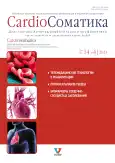Ассоциации полиморфизма rs1132896 гена матриксной металлопротеиназы 2-го типа с развитием острого нарушения мозгового кровообращения: проспективное исследование случай–контроль
- Авторы: Никулин Д.А.1,2, Чернова А.А.1,2, Никулина С.Ю.1, Прокопенко С.В.1,2, Черкашина И.И.1
-
Учреждения:
- Красноярский государственный медицинский университет им. проф. В.Ф. Войно-Ясенецкого
- Федеральный Сибирский научно-клинический центр
- Выпуск: Том 14, № 4 (2023)
- Страницы: 215-222
- Раздел: Оригинальные статьи
- URL: https://journals.rcsi.science/2221-7185/article/view/232022
- DOI: https://doi.org/10.17816/CS569019
- ID: 232022
Цитировать
Полный текст
Аннотация
Обоснование. Выявление в российской популяции новых генетических предикторов, в частности, ассоциаций полиморфизма rs1132896 гена матриксной металлопротеиназы 2-го типа (MMP-2) с развитием острого нарушения мозгового кровообращения (ОНМК), является актуальной задачей.
Цель. Изучить ассоциации полиморфизма rs1132896 гена MMP-2 с развитием ОНМК.
Материалы и методы. Объектом проспективного исследования случай–контроль выступили 318 пациентов с ОНМК (основная группа) и 323 человека контрольной группы. Возраст пациентов основной группы составил от 32 до 69 лет [57,0; 51,0–62,0]. У пациентов контрольной группы возраст был сопоставим с таковым основной группы: от 37 до 68 лет [55,0; 51,0–62,0]. Половой диморфизм был следующим: 191 мужчина (возраст [56,5; 51,0–62,0]) и 127 женщин (возраст [57,0; 51,0–62,0]). Половой состав лиц контрольной группы соответствовал таковому основной группы: 214 мужчин (возраст [55,0; 51,0–62,0]) и 109 женщин (возраст [55,0; 51,0–62,0]). Всем пациентам основной группы проводили клинический осмотр, компьютерную томографию головного мозга, электрокардиографию, эхокардиоскопию, ультразвуковое дуплексное сканирование экстракраниальных брахиоцефальных артерий, суточное мониторирование артериального давления и сердечного ритма, анализ свертывающей системы крови. Молекулярно-генетическое исследование выполняли в филиале Института цитологии и генетики СО РАН (Новосибирск). Все пациенты подписали письменное добровольное информированное согласие на участие в исследовании. Продолжительность исследования составила 3 года, первичная конечная точка исследования — диагностика ОНМК у пациентов, верификация сопутствующей сердечно-сосудистой патологии и факторов риска развития ОНМК. Статистическую обработку результатов выполняли при помощи пакетов программ SPSS Statistics v. 22 (IBM, США), MedCalc 22.006 (Microsoft, США). При сравнении протяжённых переменных применяли U-критерий Манна–Уитни. Дискретные величины сравнивали с помощью критерия χ2 Пирсона.
Результаты. При анализе статистической значимости зарегистрировано преобладание гомозиготного генотипа CC в группе больных мужчин с ОНМК: n=24 (12,6%) против n=20 (9,3%; p=0,0324). Кроме того, в группе женщин отмечено статистически значимое преобладание гетерозиготного генотипа CG у женщин с ОНМК: n=67 (52,8%) против n=42 (38,5%; p=0,0420).
Заключение. Гомозиготный генотип CC у мужчин и гетерозиготный генотип CG у женщин могут являться генетическими предикторами развития ОНМК. Изучение генетических факторов развития ОНМК необходимо для создания персонифицированного подхода к ведению пациента на амбулаторном и стационарном этапе оказания медицинской помощи.
Полный текст
Открыть статью на сайте журналаОб авторах
Дмитрий Александрович Никулин
Красноярский государственный медицинский университет им. проф. В.Ф. Войно-Ясенецкого; Федеральный Сибирский научно-клинический центр
Email: nikulin86@list.ru
SPIN-код: 7122-4397
канд. мед. наук, ассистент
Россия, Красноярск; КрасноярскАнна Александровна Чернова
Красноярский государственный медицинский университет им. проф. В.Ф. Войно-Ясенецкого; Федеральный Сибирский научно-клинический центр
Email: anechkachernova@yandex.ru
ORCID iD: 0000-0003-2977-1792
SPIN-код: 6094-7406
д-р мед. наук, профессор
Россия, Красноярск; КрасноярскСветлана Юрьевна Никулина
Красноярский государственный медицинский университет им. проф. В.Ф. Войно-Ясенецкого
Автор, ответственный за переписку.
Email: nicoulina@mail.ru
ORCID iD: 0000-0002-6968-7627
SPIN-код: 1789-3359
д-р мед. наук, профессор
Россия, КрасноярскСемён Владимирович Прокопенко
Красноярский государственный медицинский университет им. проф. В.Ф. Войно-Ясенецкого; Федеральный Сибирский научно-клинический центр
Email: s.v.proc.58@mail.ru
ORCID iD: 0000-0002-4778-2586
SPIN-код: 1279-7072
д-р мед. наук, профессор
Россия, Красноярск; КрасноярскИрина Ивановна Черкашина
Красноярский государственный медицинский университет им. проф. В.Ф. Войно-Ясенецкого
Email: cherkashina@list.ru
ORCID iD: 0000-0003-3825-3946
SPIN-код: 9715-1475
д-р мед. наук, профессор
Россия, КрасноярскСписок литературы
- Niu F, Wei B, Yan M, et al. Matrix metalloproteinase-2 gene polymorphisms are associated with ischemic stroke in a Hainan population. Medicine (Baltimore). 2018;97(39):e12302. doi: 10.1097/MD.0000000000012302
- Lucivero V, Prontera M, Mezzapesa DM, et al. Different roles of matrix metalloproteinases-2 and -9 after human ischaemic stroke. Neurol Sci. 2007;28(4):165–170. doi: 10.1007/s10072-007-0814-0
- Galis ZS, Sukhova GK, Libby P. Microscopic localization of active proteases by in situ zymography: detection of matrix metalloproteinase activity in vascular tissue. FASEB J. 1995;9(10):974–980. doi: 10.1096/fasebj.9.10.7615167
- Du J, Jin T, Cao Y, et al. Association between genetic polymorphisms of MMP8 and the risk of steroid-induced osteonecrosis of the femoral head in the population of northern China. Medicine (Baltimore). 2016;95(37):e4794. doi: 10.1097/MD.0000000000004794
- Romanic AM, White RF, Arleth AJ, et al. Matrix metalloproteinase expression increases after cerebral focal ischemia in rats: inhibition of matrix metalloproteinase-9 reduces infarct size. Stroke. 1998;29(5):1020–1030. doi: 10.1161/01.str.29.5.1020
- Clark AW, Krekoski CA, Bou SS, et al. Increased gelatinase A (MMP-2) and gelatinase-B (MMP-9) activities in human brain after focal ischemia. Neurosci Lett. 1997;238(1–2):53–56. doi: 10.1016/s0304-3940(97)00859-8
- Mun-Bryce S, Rosenberg GA. Matrix metalloproteinases in cerebrovascular disease. J Cereb Blood Flow Metab. 1998;18(11):1163–1172. doi: 10.1097/00004647-199811000-00001
- Fatar M, Stroick M, Griebe M, Hennerici M. Matrix metalloproteinases in cerebrovascular diseases. Cerebrovasc Dis. 2005;20(3):141–151. doi: 10.1159/000087197
- Rosenberg GA, Navratil M. Metalloproteinase inhibition blocks edema in intracerebral hemorrhage in the rat. Neurology. 1997;48(4):921–926. doi: 10.1212/wnl.48.4.921
- Vecil GG, Larsen PH, Corley SM, et al. Interleukin-1 is a key regulator of matrix metalloproteinase-9 expression in human neurons in culture and following mouse brain trauma in vivo. J Neurosci Res. 2000;61(2):212–224. doi: 10.1002/1097-4547(20000715)61:2<212::AID-JNR12>3.0.CO;2-9
- Cunningham LA, Wetzel M, Rosenberg GA. Multiple roles for MMPs and TIMPs in cerebral ischemia. Glia. 2005;50(4):329–339. doi: 10.1002/glia.20169
- Liu L, Sun J, Li G, et al. Association between MMP-12-82A/G polymorphism and cancer risk: a meta-analysis. Int J Clin Exp Med. 2015;8(8):11896–11904.
- Jia P, Wu N, Zhang X, Jia D. Association of matrix metalloproteinase-1-519A/G polymorphism with acute coronary syndrome: a meta-analysis. Int J Clin Exp Med. 2015;8(4):5675–5682.
- Zhang Y, Wang M, Zhang S. Association of MMP-9 gene polymorphisms with glaucoma: a meta-analysis. Ophthalmic Res. 2016;55(4):172–179. doi: 10.1159/000443627
Дополнительные файлы







